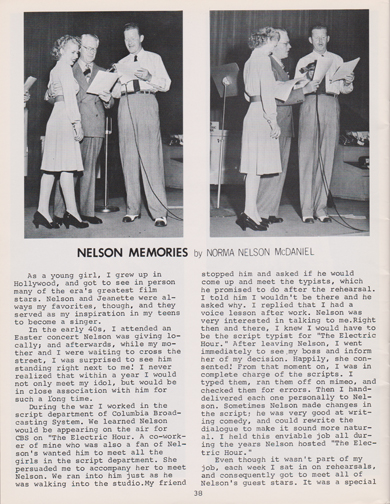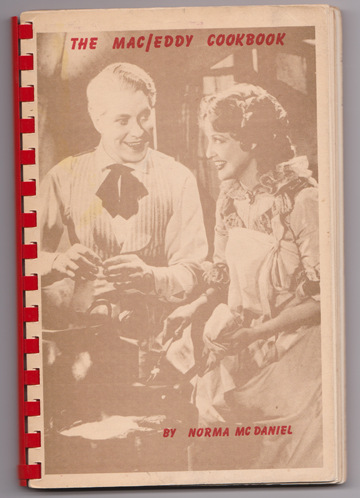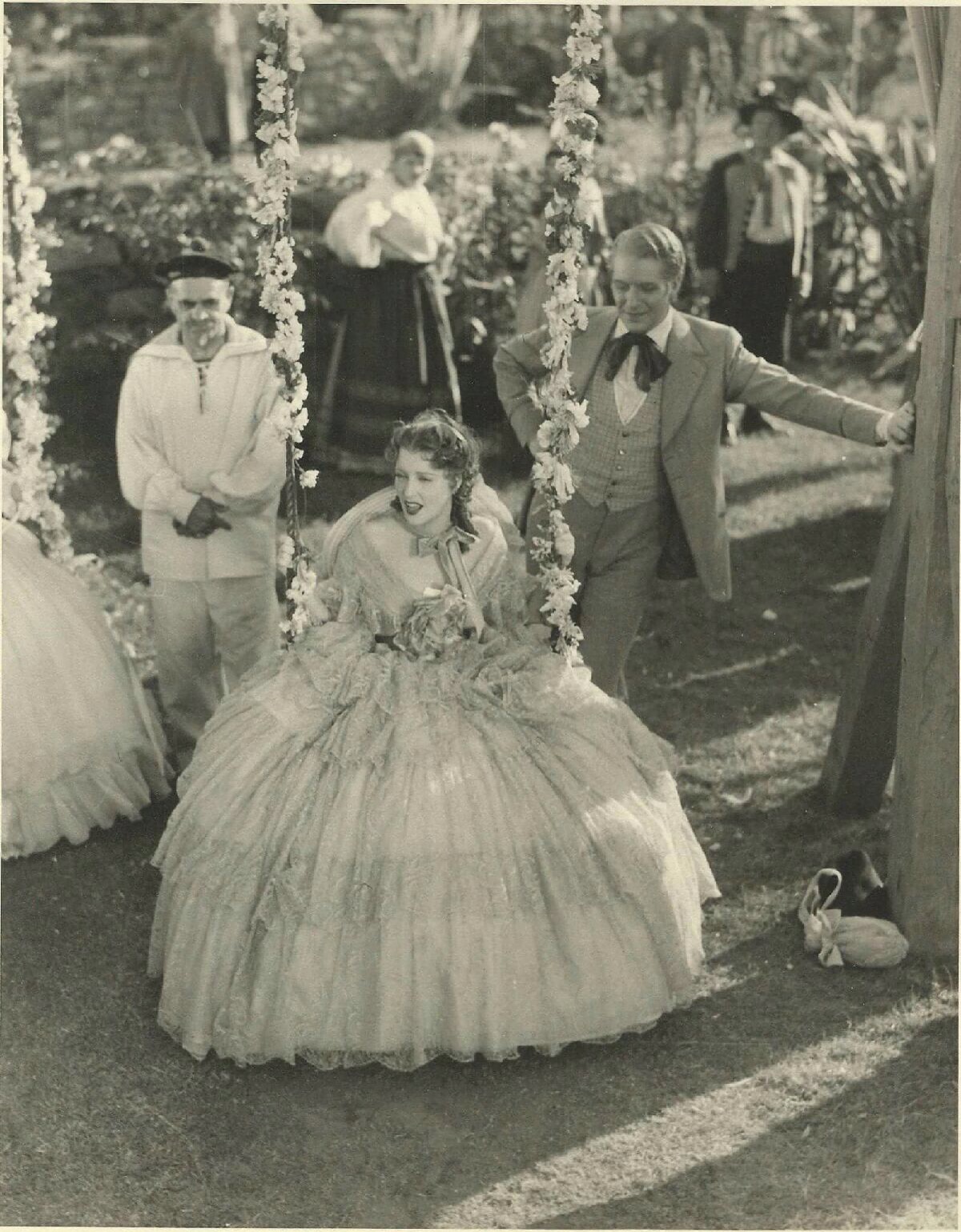Norma Nelson, “The Electric Hour” script girl, an update

The photo above shows Nelson Eddy live on the radio with his “Electric Hour” script girl, Norma Nelson. But this radio show is NOT “The Electric Hour”, it’s Art Linkletter’s “House Party.” This was the venue chosen to introduce Norma as a singer and Nelson endorsed and introduced her as his protege. Smart move because had her debut been on Nelson’s radio show, the already rampart rumors about them might have escalated even further…angering both Jeanette and Ann Eddy for sure.
We met Norma Nelson (married name McDaniel) in the late 1970s. She had a difficult life, living alone with her young son who had Down Syndrome. I never met her older daughters. Her son was a very sweet and affectionate childlike young man but Norma had very little social life. She appreciated that we were relaxed around her son and so we became friends. Norma spoke candidly about Nelson, even to telling us that she’d asked Nelson to be his godfather at birth but that Nelson had declined.
Norma agreed to speak at an early club meeting and came to several others and enjoyed being important again with Nelson’s fans. She gave us a copy of her radio appearance on “House Party” so that we could put that out on LP. And we still have it on this on our CD JN128A at this link.
Norma also wrote an article for Journal #4 of Mac/Eddy Today, see below. (The original magazine is re-published here.)


Norma also had a great idea to put together a Mac/Eddy cookbook with theme foods from their films. It WAS a great idea, she had fun putting Volume 1 together and we were able to give her money from the proceeds of which she was most appreciative. See the photos below.


Norma was a very sweet lady but I fear that once I let her know that I would use her original interview with us in Sweethearts – she did give us permission after all and was glad to talk about it at early LA club meetings – suddenly she realized that it would be her admitting that she “messed around” a bit with Nelson who was after all, a married man! (No, they didn’t have sex, we asked point blank about that.) She had never minded people knowing this before and also admitted with no reservation some details of Nelson’s life that his voice teacher Eduoard Lippe told her!
The facts are that Nelson arranged for her to study with Lippe and at some point, Nelson showed up at Lippe’s for her voice lessons..and here I quote exactly what I wrote in Sweethearts which was basically transcribed from what Norma told me and Diane Goodrich:
Before the lesson, Lippe left them alone to ‘talk.’ Norma admitted that they kissed and there was some ‘petting’ but it didn’t progress beyond that. Lippe told her that Nelson and Jeanette were lovers but when she asked Nelson about it, he denied it saying they were just friends. Lippe also told Norma that Nelson’s marriage was a mess and that he should have married someone like Norma.
Norma had a front row seat in the audience for each broadcast and soon the trades were commenting on the “romance.” Later on, their relationship waned. Nelson became furious when Lippe tried to tell Norma she was a mezzo and he found another teacher for her, Major Herbert Wall, with whom Nelson had just begun his training.
I moved to New York in the mid ’80s so I don’t know what happened to Norma in later years except that she also moved out of state at some point to live with her family. We were out of touch except for letters here and there. It would appear that she had second thoughts about going on record as I never heard from her again after I wrote her letting her know Sweethearts was coming out in 1994.
It seems she wrote a letter to Gene Raymond dated August 24, 1994 in which she basically grovels and apologizes to him for having ever spoken to me or having anything to do with our group. This was literally about a month or so before Sweethearts hit bookstores. Damage control, anyone?
Lest anyone be annoyed at her trying to publicly backpedal on what she’d said before, please note that there were several sources who freaked out once they were questioned or attacked for their statements. Some were vaguely threatened with lawsuits from the Jeanette fan club. It took a lot of courage to speak the truth! Norma’s original article that she wrote for us was in 1978…it was published in 1978…that’s 1978, folks!…Twelve years before I ever laid eyes on any 1940s correspondence of Isabel Eddy’s where she describes her son “beaming like a headlight” when Jeanette was with him. Twelve years before I saw written documentation also from the 1940s by Lucille Mereto covering all of Nelson’s radio shows and noting the drastic difference in Nelson’s demeanor when Jeanette was his guest.
And yes, Norma’s information and observations ring true. Readers today can appreciate that Norma Nelson was cautiously honest when she wrote about Jeanette’s appearances on “The Electric Hour”:
“She was gorgeous. When she walked into a room, heads turned. Nelson was very proud of her, proud to be associated with her. He positively beamed. His solicitousness with her was a pleasure to behold. He’d hold her script, hold her hand, and see to her every comfort. This treatment was never enjoyed by any of his other guest stars that I noticed.”
PS: Norma told us that she believed what Lippe told her, that Nelson and Jeanette were lovers. When Nelson denied it, Norma assumed – hoped – that maybe there was a chance for her to be in his life. Who can blame her? But she learned (also from Lippe) that Nelson had a wife he couldn’t get rid of. Norma was finally realistic enough to understand there was no future on a personal front with Nelson. She moved on with her life.
We are grateful to Norma for the information she freely shared. Every piece of information has helped to put together the bigger picture of how the Jeanette-and-Nelson story played out.






